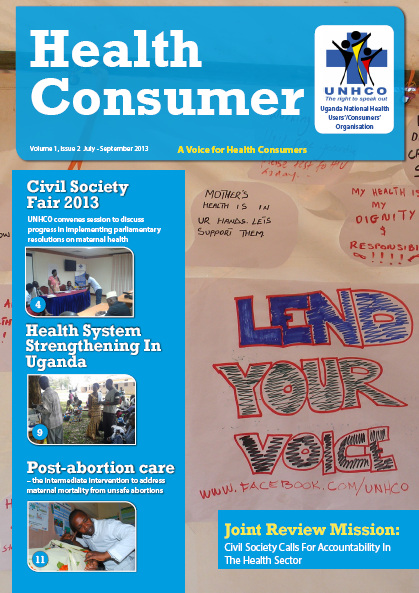
|
|
Uganda National Health Users/ Consumers Organisation
UNHCO Newsletter |
Context
The government of Uganda is committed to ensuring access of all people to high quality health care services as granted in the constitution of Uganda.
Community monitoring is also enshrined in the constitution 1995; Article 38. This guarantees the sovereignty of citizens of Uganda in the governance of the country particularly showing how central the citizen’s power is in governance and management of public affairs of the country. Although the previous steps are important, there are serious limitations in relation to access to information, multi party politics, high levels of illiteracy and citizens’ awareness of their rights. For the last ten years, UNHCO in the districts of Masaka, Oyam, Nakaseke, Bushenyi, Luweero, Iganga, Dokolo, Apac and Mubende. The community monitoring projects works from the the village level through to the district level. UNHCO represents civil society at different committees in the ministry of health, including the Health Policy Advisory Committee (HPAC), Country Coordinating Mechanism (CCM) of the Global Tuberculosis, AIDS and Malaria Fund, Public Private Partnership in Health (PPPH). UNHCO has been selected to lead the Health Thematic Working Group of the Civil Society Accountability Platform – a civil society platform that was formulated to provide a reflection space for CSOs engaged in accountability work in order to strengthen synergy and accountability; UNHCO also spearheaded the development of the Patients’ Charter, whose objective is to provide a policy and legal framework for empowerment of health consumers, enabling them to demand for high quality health care and promote accountability in the health sector. |
Area of Work
Uganda Contact Person
Robinah Kaitiritimba |
Approaches to implementing Community monitoring/ accountability
The approach used is multi-pronged that ensures that there is capacity strengthening, engagement of stakeholders and interface with policy formulators. The main tool employed is the community scorecard (CSC) methodology to exact social and public accountability and responsiveness from service providers. The CSC is also used in its four adapted generic components:
- The Input Tracking Matrix – is a simple comparison of factor inputs actually available for against entitlements. Often the mere process of letting communities/beneficiaries know their entitlements against what is available is significantly empowering since most of the time they have no access to such information.
- The Community Generated Performance Scorecard - is a quick table summarizing the community’s feedback on the performance of different services or projects. It is a key output generated through community engagement. The performance criteria used for judging performance health are generated by the community themselves and performance parameters like availability, access, transparency, reliability, quality and satisfaction.
- The Self-Evaluation Score card by service providers like with the community, it is a meeting of service providers to come up with performance criteria to assess their own performance in providing the service.
- The interface meeting between users and providers – is a meeting used to provide respective feedback from the community and self-evaluation scorecards and generate a mutually agreed “reform” package (agenda for change) through action planning on the recommendations that both sides had made independently.
Results and Lessons
Community monitoring has the potential to change things, it is also more realistic, focuses on community needs, and it is an important tool for influencing policy and practice and for putting government on pressure. However, it needs a lot of patience and resources.

